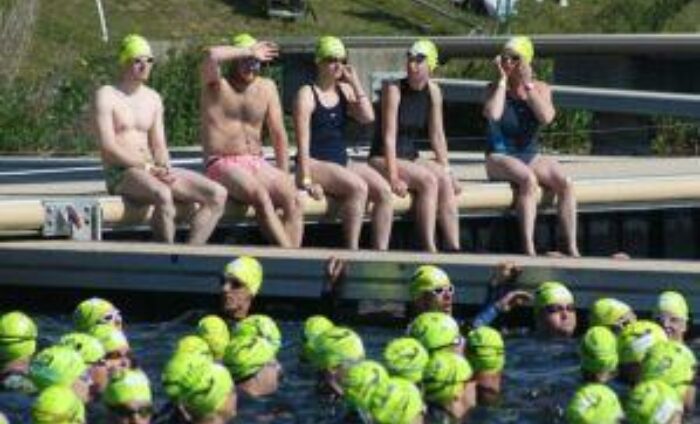
Don’t “smash it”
Thanks to Fiona Ford for the idea for this post. Fiona writes swim training sessions for H2Open and also runs Swim Smooth squad sessions in Richmond-upon-Thames. A key part of those sessions is training at or around Critical Swim Speed (CSS). In order to measure CSS, she regularly asks her swimmers to do 400m and 200m time trials, and her advice is always: “Don’t try to smash it!”
At first glance, this might sound like odd advice. The idea of “smashing it” or some equivalent is compelling. It’s you against the clock and the water and you need to pump yourself up for a maximum effort blast. You need to be mentally strong to overcome the pain in your oxygen starved muscles. You have to blank out negative thoughts. “Smashing it” seems to capture all those ideas very well.
But “smashing it” can be unhelpful in swimming. Firstly (and this is very common), approaching a race or a time trial with the aim of “smashing it” will almost certainly cause you to swim too fast at the beginning. You will sprint off and then fight to hang on to that speed as long as possible. At almost every open water swimming race I’ve done there have been people who have powered through the first 100m and then slowed dramatically. Adopting the mindset of ‘smashing it’ can be an indicator of lack of swimming racing experience and may substitute for a proper plan or strategy or it might reflect an approach that’s worked for the athlete in other sports.
The reality is that, open water racing tactics aside, the fastest way to cover a fixed distance in swimming is usually either a constant speed or with a slight increase in speed in the latter stages. Look at the 50m split times for 1500m world record holder Sun Yang for example (see below). The first 50m is slightly faster because of the dive start but from then on, the speed is constant until the last 100m, when he sprints. As a comparison, I’ve included his splits on the 400m final (that he also won), which shows how much he was holding back at the start of the 1500m.
This type of pacing is not compatible with “smashing it”. Swimming rewards patience and consistency over brute force – and that’s true for both a 400m time trial and your long-term development as a swimmer. To swim your fastest (whatever your speed) you will almost certainly have to start a race at a pace that feels slow. Use the first 100m to settle into a rhythm and ensure you are swimming with your best technique rather than putting yourself deeply into oxygen debt.
It’s a skill to learn what this pace is (but regular training based on CSS will help) and then approach a race with the right mind-set to apply it.
The one possible exception to this advice is a mass participation race where a short sprint at the beginning could help you find a faster pair of feet to draft later on or keep an eye on a particular rival but this approach should really be used with caution.
Secondly, planning on “smashing it” conditions you to expect pain, and therefore tense up in anticipation. But tension will slow you down and cause fatigue. To swim fast you need to relax. This is even true over a 50m sprint. Former 50m world record holder Mark Foster once told H2Open that one of the keys to his success was his laid-back approach to life and ability to be totally relaxed during a race. It’s even more true on longer swims.
In my own experience – and I’ve heard other people say similar things – some of my fastest swims over a whole range of distances have been the least painful. Some have been so easy I’ve almost felt guilty. If you get the pacing right from the start and stay calm and loose, speed seems to follow automatically. Start fast and tense and the likelihood is that you will suffer in the latter part of the swim and your performance will be poor.
So next time you’re doing a race, don’t “smash it” but stay calm and relaxed, control your pace, enjoy your swim and hopefully swim fast.
Sun Yang’s 50m splits during the 1500m final and the 400m at the 2013 world championships in Barcelona
| Split | ||
|---|---|---|
| Distance | 1500m | 400m |
|
50m |
27.13 |
26.13 |
|
100m |
29.37 |
27.98 |
|
150m |
29.82 |
27.81 |
|
200m |
30.17 |
28.63 |
|
250m |
29.30 |
28.30 |
|
300m |
29.46 |
28.79 |
|
350m |
29.26 |
27.40 |
|
400m |
29.37 |
26.55 |
|
450m |
29.39 |
|
|
500m |
29.68 |
|
|
550m |
29.57 |
|
|
600m |
29.57 |
|
|
650m |
29.48 |
|
|
700m |
29.65 |
|
|
750m |
29.57 |
|
|
800m |
29.81 |
|
|
850m |
29.29 |
|
|
900m |
29.87 |
|
|
950m |
29.77 |
|
|
1000m |
29.95 |
|
|
1050m |
29.44 |
|
|
1100m |
29.73 |
|
|
1150m |
29.64 |
|
|
1200m |
29.79 |
|
|
1250m |
29.67 |
|
|
1300m |
29.87 |
|
|
1350m |
29.69 |
|
|
1400m |
29.13 |
|
|
1450m |
27.37 |
|
|
1500m |
27.11 |
|







